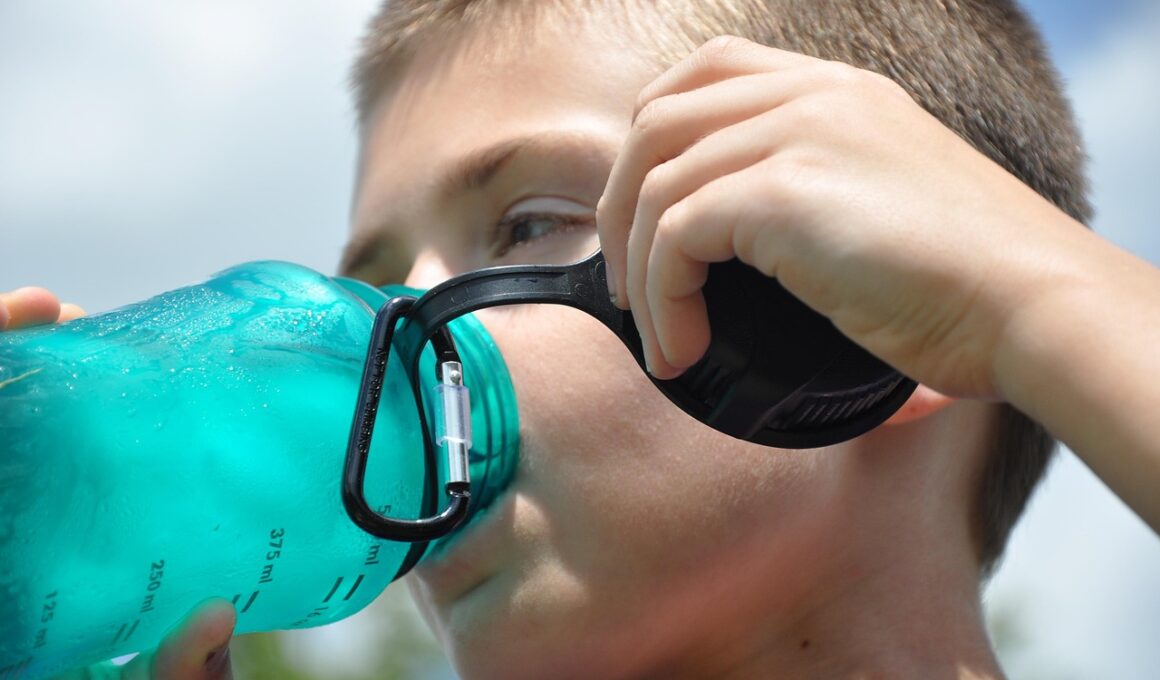Hydration Monitoring in Youth Athletes: Methods and Considerations
Proper hydration is vital for youth athletes, especially during intense training or competitive events. Understanding hydration status helps coaches and parents optimize performance and reduce the risk of heat-related illnesses. There are various methods to monitor hydration, each with its advantages and disadvantages. These include body weight tracking before and after activities, using urine color charts, and regular fluid intake assessments. Body weight fluctuations can indicate hydration changes, while urine color reflects hydration levels; these methods are practical and cost-effective. Other options include more advanced techniques like bioelectrical impedance analysis and thirst perception assessments. Coaches and trainers must choose the right monitoring methods based on accessibility and specific needs. Education covering the signs of dehydration is also crucial as parents should be aware of the symptoms related to dehydration, such as fatigue, dizziness, and reduced urine output. By integrating effective hydration monitoring practices, youth athletes can perform better. Raising awareness around the importance of hydration is fundamental in training environments, contributing to an athlete’s overall well-being and success.
Hydration monitoring methods vary widely in terms of availability and reliability. One common practice involves athletes weighing themselves before and after physical activities, which helps measure fluid loss due to sweat. This method is straightforward but requires consistency in conditions. Understanding sweat rate plays a critical role in hydration strategies for athletes. Coaches can calculate how much fluid a young athlete needs to replace based on this data, ensuring optimal hydration levels are maintained. Another practical method is assessing urine color; lighter-colored urine typically indicates better hydration. Athletes can carry simple hydration monitoring tools like color charts for quick assessments. Furthermore, observing athletes’ thirst cues remains essential; young athletes might not recognize when they are dehydrated, emphasizing the importance of parental or coach intervention. Additionally, utilizing technology, such as smart water bottles that track intake, can support hydration monitoring more dynamically. However, technology comes with challenges such as data overload and potential dependency. In summary, maintaining hydration is crucial, requiring a mix of traditional and modern methods tailored to youth athletes’ unique needs.
Understanding Sweat Loss in Athletes
Monitoring sweat loss is essential to maintaining hydration levels. Sweating is the body’s primary means of regulating temperature during physical activities, and it leads to significant fluid loss, especially during long or intense training sessions. Athletes need to be aware of their specific sweat rates, as this can vary based on multiple factors, including age, environment, and training intensity. Conducting sweat tests can provide insights into how much fluid athletes lose over time during exercise. This information is critical for developing personalized hydration strategies tailored to each athlete’s needs. Coaches should implement periodic evaluations during practices and competitions to track athletes’ hydration status. Additionally, understanding the role of electrolyte loss during sweating is equally important. Replenishing these lost minerals through sports drinks or electrolyte tabs post-activity can aid recovery and improve performance. Educating athletes about the implications of dehydration and consistent hydration practices forms a partnership between coaches and young athletes, enhancing both individual and team success during competitive events. Hydration education should be ongoing, incorporating hands-on practices and real-time assessments.
In some instances, youth athletes may not actively express their thirst, leading to inadequate hydration. This silent dehydration can impede their performance, emphasizing the need for proactive measures in hydration strategies. Coaches and parents should encourage regular drinking intervals, especially during practice sessions to combat the risks of dehydration. Monitoring fluid intake helps parents ensure that athletes adhere to proper hydration practices. Providing athletes with water bottles can facilitate this process and make hydration readily accessible during training and competitions. Establishing a routine for hydration can positively impact young athletes by minimizing the chances of fatigue. Furthermore, incorporating educational seminars that include hydration principles could reinforce habits among youth athletes, making them aware of the signs of dehydration. Additionally, integrating hydration discussions into training routines can help build a culture of hydration, promoting long-term health and performance benefits. Parents should be involved in hydration education to create a supportive environment. By prioritizing hydration, coaches and parents can foster healthy habits that will last a lifetime, ultimately improving athletic performance.
The Role of Technologies in Hydration Monitoring
Recent advances in technology have opened up new avenues for monitoring hydration in youth athletes. Wearable devices, such as smart watches and hydration-monitoring apps, can track fluid intake and loss dynamically. These gadgets provide real-time data, allowing athletes and coaches to adjust hydration strategies promptly. The integration of technology helps athletes become more accountable for their hydration habits, making them actively engaged in their health. However, while these devices can enhance hydration monitoring accuracy, they may also lead to confusion if not understood properly. Educators and coaches must ensure that young athletes grasp how to interpret and act on the data provided by these technologies effectively. Moreover, complementary strategies that leverage teamwork in hydration planning can be beneficial. For instance, group hydration challenges can motivate athletes to drink more. While technological innovations play a key role, traditional hydration methods should also be maintained. A holistic approach that combines technology and hands-on practices ensures better hydration management for youth athletes, enhancing their activities and competitions significantly.
Education about hydration should also focus on nutrition, as the food we consume affects hydration levels. Maintaining a well-balanced diet rich in water-dense foods like fruits and vegetables can help young athletes stay hydrated more efficiently. Educators can incorporate nutrition education into hydration plans, ensuring young athletes understand how their overall diet impacts performance. For instance, meals that contain high sodium can lead to increased thirst and excessive fluid intake, so appropriate choices are essential. Practical cooking demos featuring hydration-friendly meals can engage young athletes, showing them how to incorporate healthy foods into their diets. Additionally, understanding timing is crucial; consuming specific hydrating foods can create synergy with traditional fluid intake before, during, and after physical activities. Athletes need guidance on how to create a meal plan that aligns with their training schedules. Collaborations with nutritionists can fortify these education efforts by providing specialized insights into dietary hydration needs tailored for youth athletes. This comprehensive perspective ensures students recognize all aspects of hydration support necessary for optimal performance.
Long-term Implications of Hydration Practices
The long-term health implications of proper hydration practices build a foundation for a successful athletic career. Chronic dehydration during formative years can lead to lasting health consequences, including decreased kidney function and hindered athletic development. Youth athletes who neglect hydration may encounter muscular and cognitive performance declines, affecting their overall training outcomes. Fostering lifelong hydration habits early can prevent these issues, allowing young athletes to thrive both on and off the field. The involvement of coaches and parents remains pivotal in emphasizing the essential nature of hydration. Encouraging self-regulation regarding fluid intake cultivates responsible behaviors as they transition into adult athletes. Furthermore, building a community around hydration prioritizes collective awareness and accountability, ultimately enhancing performance. Athletes can become advocates for hydration education, sharing their knowledge and experiences to foster a cohesive culture that recognizes every athlete’s hydration needs. Future generations will benefit from these sustained practices, demonstrating that hydration is not just a competition tactic but a fundamental component of athleticism. Therefore, adopting a holistic hydration approach will shape a healthier, more informed community of athletes.
Promoting hydration strategies for youth athletes necessitates a collaborative effort among stakeholders, including coaches, parents, schools, and sports organizations. Aligning hydration practices across these sectors helps create a consistent message advocating the importance of fluid intake. This collective approach can establish hydration guidelines tailored to different sports, effectively standardizing monitoring practices. Workshops and school programs focusing on hydration monitoring can reinforce these efforts, increasing knowledge and encouraging participation. Generating awareness will lead to better hydration habits sustaining both physical and psychological performance in athletes. Empowering athletes by providing tools to monitor their hydration status fosters independence while ensuring they remain healthy. Such initiatives not only enhance athletic performance but also support students’ overall well-being. Regular assessments and sharing information on the effectiveness of different strategies can help refine these practices over time, ensuring continuous improvement. Additionally, maintaining an ongoing dialogue about hydration within the athletic community can facilitate innovative strategies and share best practices. Schools and clubs that collaborate on hydration initiatives can create an environment where youth athletes can flourish, ultimately upping the ante for athletic performance.


